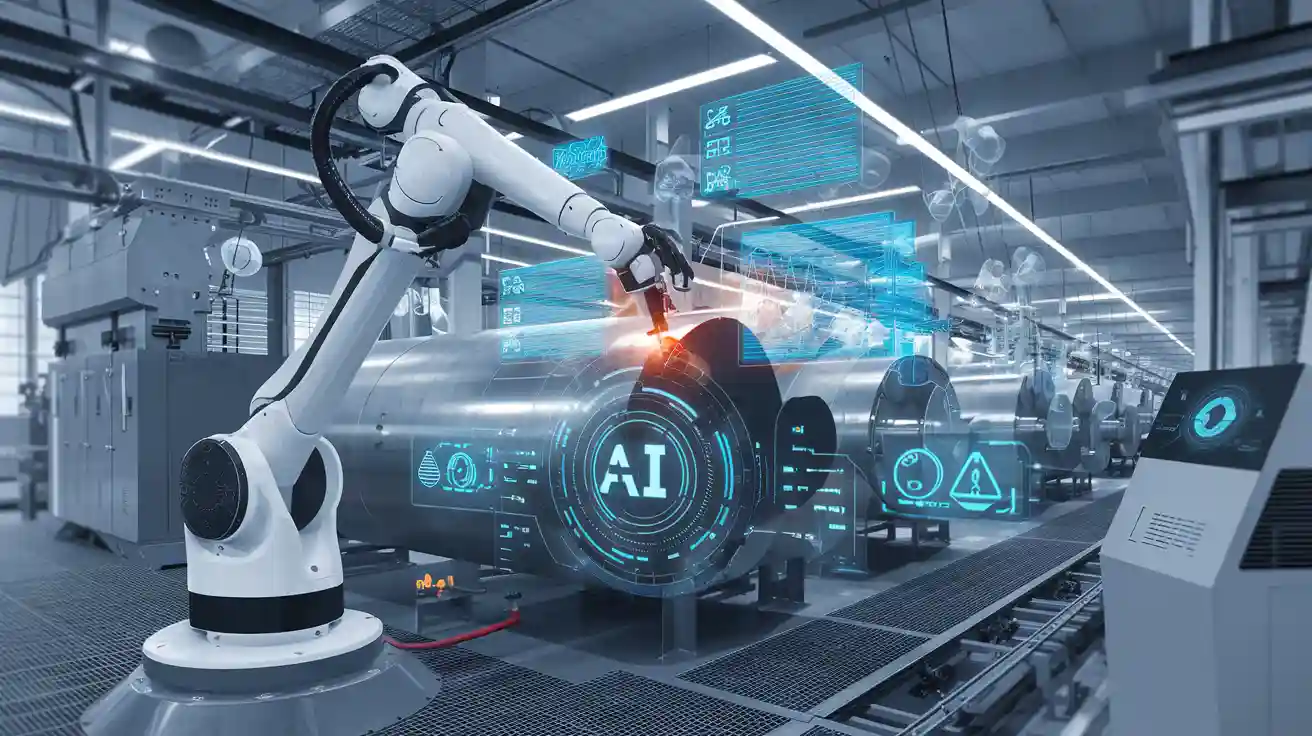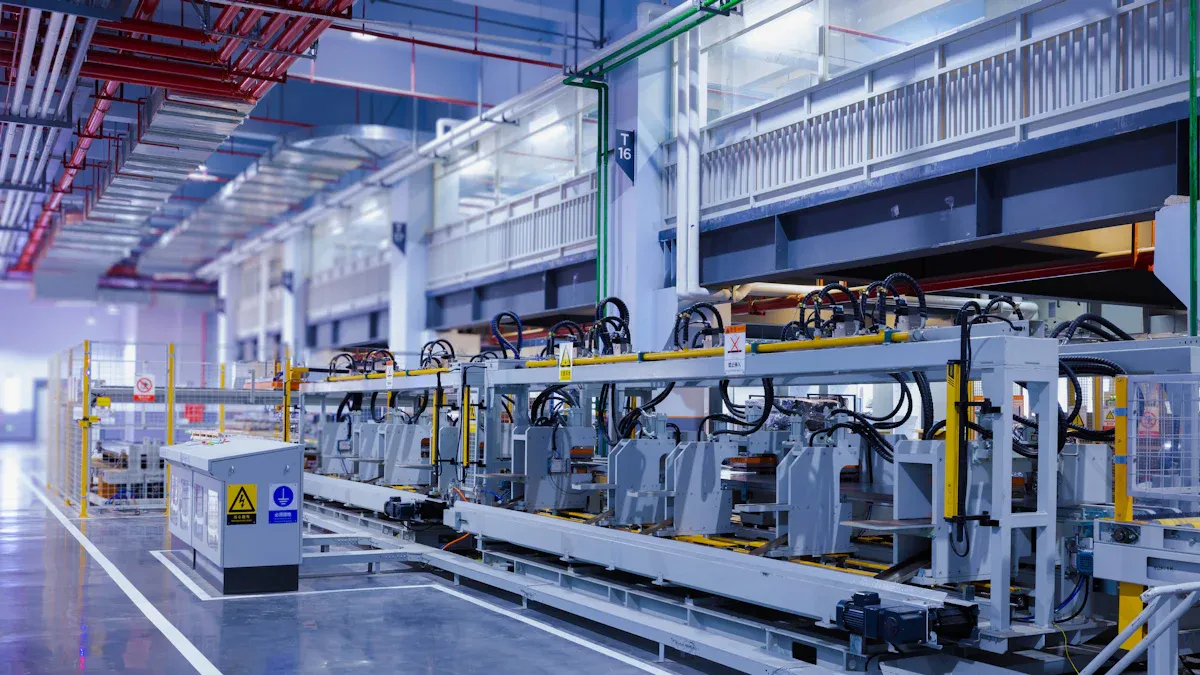
AI for predictive maintenance transforms how you manage industrial equipment. You can expect up to 70% fewer equipment failures, 50% less unplanned downtime, and 30% lower maintenance costs with ai-powered predictive maintenance. The table below highlights the impact of ai for predictive maintenance in reducing downtime and maximizing asset value.
|
Metric |
Improvement/Reduction |
|---|---|
|
Unplanned downtime reduction |
50% |
|
Maintenance cost decrease |
30% |
|
Equipment failures reduction |
70% |
|
Equipment lifespan extension |
20-40% |
Key Takeaways
-
AI-powered predictive maintenance cuts equipment failures by up to 70%, reduces downtime by 50%, and lowers maintenance costs by 30%, helping you save money and keep operations running smoothly.
-
Using smart sensors, machine learning, and digital twins lets you monitor equipment in real time, predict problems early, and plan maintenance only when needed, improving safety and extending asset life.
-
Follow a clear step-by-step process: collect data with IoT sensors, analyze it with AI, track key metrics, and automate maintenance actions to boost efficiency and reduce manual errors.
AI-powered predictive maintenance

Evolution of predictive maintenance
You have seen a major shift in how industries approach equipment care. In the past, you relied on reactive repairs or fixed schedules. This often led to unexpected failures and wasted resources. Traditional predictive maintenance used static rules and fixed thresholds. You needed to manually tune these systems and diagnose problems after alerts.
Now, ai-powered predictive maintenance changes the game. You use machine learning and real-time data to predict failures before they happen. This approach adapts to changing asset conditions and automates diagnostics. You no longer depend on guesswork or rigid schedules. Instead, you benefit from continuous learning and dynamic response.
AI-driven predictive maintenance reduces operational downtime by up to 50% and maintenance costs by about 25% compared to reactive methods. You gain improved sustainability, enhanced safety, and greater operational agility.
The evolution is clear in the numbers:
|
Metric / Example |
Description |
Impact / Result |
|---|---|---|
|
Manufacturers using predictive maintenance see this drop compared to reactive approaches. |
Less unplanned downtime, better continuity. |
|
|
10-40% Decrease in Maintenance Costs |
Targeted, data-driven maintenance cuts expenses. |
Lower costs, optimized resources. |
|
78% Manufacturing Executives (2023) valuing predictive analytics |
Up from 47% in 2018. |
Shows a major shift toward AI-driven strategies. |
|
BMW’s Zero-Defect Production |
Uses real-time data and machine learning. |
31% less quality-related rework. |
|
General Motors’ Predictive Maintenance |
Forecasts failures with 85% accuracy. |
40% less unplanned downtime. |
You now use ai for predictive maintenance to move from reactive to proactive strategies. This shift marks a new era in industrial operations.
Key technologies
You rely on several core technologies to make ai-powered predictive maintenance possible:
-
Machine learning algorithms analyze historical and live data. They detect anomalies, predict failures, and optimize maintenance schedules.
-
IoT sensors collect real-time data on temperature, vibration, pressure, and more. These sensors stream information to digital twins and analytics platforms.
-
Digital twins create virtual models of your equipment. They integrate sensor data and simulate asset health, helping you predict issues and plan maintenance.
-
Edge computing and cloud platforms process large volumes of sensor data. They enable fast ai inference and support scalable solutions.
-
Explainable AI helps you understand how predictions are made. This builds trust and supports better decision-making.
You use ai for predictive maintenance to process unstructured data like audio, images, and maintenance logs. Natural language processing and computer vision detect issues such as abnormal noises or corrosion. AI agents automate workflows and integrate with your operational systems. This reduces manual effort and enables proactive, autonomous maintenance.
Research shows that integrating IoT sensors, machine learning, and digital twins leads to measurable improvements. You see reduced downtime, lower costs, and extended asset life. In manufacturing, you can achieve up to 30% less downtime and longer component life. In energy utilities, you benefit from 25% fewer maintenance trips.
With ai technologies in predictive maintenance, you gain cost optimization, improved safety, and effective resource allocation. You also support sustainability and continuous innovation.
Real-time monitoring
Real-time monitoring stands at the heart of ai-powered predictive maintenance. You use smart sensors to track equipment health every second. These sensors measure vibration, temperature, pressure, and more. The data streams to edge or cloud platforms, where ai inference engines analyze it instantly.
-
Power plants use vibration analysis, thermal imaging, and acoustic sensors to monitor turbines and generators. You compare real-time data to historical baselines to spot early signs of wear.
-
Wind farms combine vibration and stress sensors with weather data. You monitor turbine health remotely and schedule maintenance before failures occur.
-
Water utilities use acoustic sensors and ai to detect leaks and predict pipeline failures. You analyze flow, pressure, and water quality data for early warnings.
-
Automotive plants use predictive maintenance to cut unplanned downtime by 83% and maintenance costs by 47%. Product quality improves by 23% through real-time monitoring.
You benefit from dashboards that visualize sensor data. These tools help you make quick, informed decisions. Smart building systems use real-time monitoring to detect HVAC issues early, saving energy and preventing breakdowns. In rail networks, vibration sensors detect track wear, and acoustic monitoring finds failing bearings long before failure.
IoT-based smart sensor tags give you actionable insights. According to industry reports, companies using ai for predictive maintenance with IoT sensors see up to 25% less equipment downtime and 10-20% lower maintenance costs.
You now rely on ai inference at the edge and in the cloud to process massive data streams. This enables near-instant anomaly detection and predictive modeling. You can act before problems escalate, keeping your operations efficient and safe.
Benefits and implementation
Benefits of ai for predictive maintenance
You gain significant advantages when you use ai for predictive maintenance. This approach delivers reduced downtime, cost savings, and increased equipment lifespan. In heavy industries, ai-powered predictive maintenance can cut downtime by 30-50% and lower maintenance costs by up to 40%. You improve operational reliability and manufacturing efficiency by detecting equipment wear early and optimizing maintenance schedules. This proactive method extends asset life by up to 20%, reduces unplanned stoppages, and helps you manage resources better. You also see improved safety, fewer workplace incidents, and enhanced sustainability through reduced energy use and material waste. With data-driven insights, you make smarter decisions and achieve operational excellence.
Companies in manufacturing, automotive, and energy sectors report up to 50% less unplanned downtime and 10-40% lower maintenance costs after adopting ai for predictive maintenance.
Predictive maintenance implementation
You follow a clear process for predictive maintenance implementation:
-
Start with data collection and analysis using IoT sensors to capture real-time equipment data.
-
Integrate this data into your maintenance management systems for centralized tracking.
-
Use machine learning models to analyze historical and live data, predicting failures and optimizing maintenance schedules.
-
Monitor key performance indicators like equipment uptime and maintenance costs through dashboards.
-
Automate decision-making by triggering maintenance actions based on ai predictions.
This step-by-step approach ensures you maximize manufacturing efficiency and reduce manual errors. You see measurable improvements such as 10-15% lower maintenance costs and a 20-30% increase in planned maintenance activities within the first year.
Challenges and solutions
You may face challenges with data quality, integration, and workforce expertise during predictive maintenance implementation. Data from different sources can be inconsistent or outdated, making reliable predictions difficult. Integration with existing systems often requires robust data governance and technical support. A shortage of skilled ai specialists can slow progress. You overcome these hurdles by investing in data cleaning, staff training, and pilot projects. Explainable ai builds trust by showing how predictions are made, helping you adopt ai for predictive maintenance with confidence. Real-world examples show that companies who address these challenges achieve higher manufacturing efficiency and long-term success.
You see ai for predictive maintenance transforming industrial equipment management. With ai, you reduce downtime, extend asset life, and boost safety. You follow clear steps to implement predictive maintenance. The future looks strong—ai for predictive maintenance drives growth, as shown below:
|
Statistic / Trend |
Value / Projection |
Relevance |
|---|---|---|
|
AI market growth in manufacturing |
Rapid expansion |
|
|
Workforce productivity increase |
40% |
Higher efficiency |
|
Global economic boost by 2030 |
$15.7T |
Major impact |
You can expect ai for predictive maintenance to shape the next era of industrial operations.
FAQ
What types of equipment benefit most from ai-powered predictive maintenance?
You see the best results with rotating machinery, pumps, motors, conveyors, and HVAC systems. These assets generate continuous data, which ai uses to predict failures.
How does ai improve maintenance scheduling?
Ai analyzes real-time sensor data and historical trends. You receive alerts before failures happen. This helps you schedule maintenance only when needed.
Can you integrate ai with existing maintenance systems?
Yes, you can connect ai platforms to most modern maintenance management systems. You gain seamless data flow and automated insights for better decision-making.
